
A
PPENDIX
154 / 157
System 6844(RC) - V03.00
hopf
Elektronik GmbH
Nottebohmstr. 41
• D-58511 Lüdenscheid • Tel.: +49 (0)2351 9386-86 • Fax: +49 (0)2351 9386-93 • Internet: http://www.hopf.com • E-Mail: [email protected]
12.2 GPS (Global Positioning System)
Satellites circumnavigate the earth about twice per day at an altitude of approximately
20,000 km, on 6 different courses and at different angles.
The GPS system was developed based on 18 satellites with 3 replacement satellites. In or-
der to prevent short-term gaps in coverage the number was increased during development to
21 satellites with 3 replacement satellites. Above any point on the skyline, therefore, there
are always between 6 and 11 satellites visible. Highly precise atomic clocks are on board
every satellite (accuracy min. 1*10
-12
).
A base frequency of 10.23 MHz is taken from the atomic clocks. The two carrier frequencies
used, L1 and L2, are produced from this base frequency.
Transmission frequency L1 = 154 * Base frequency = 1575.42 MHz
Transmission frequency L2 = 120 * Base frequency = 1227.60 MHz
Each satellite sends all important navigation and system data by modulation on these two
carrier frequencies. In the public domain, data transmitted on L1 frequency may be evaluat-
ed. The precise time can be calculated from this data by defining the position via the anten-
na.
The GPS antenna receives the signals of all satellites that are within sighting range above
the skyline and forwards them to the GPS receiver via a coaxial cable. 4 satellites are re-
quired for continuous time evaluation.
hopf
GPS radio-controlled clocks have a
Position-fix function
for difficult antenna posi-
tions that do not permit continuous reception from 4 satellites (where satellite signals may be
screened by surrounding buildings or in mountain valleys, for example). This function also
permits synchronization with only one satellite.
Time calculation
The GPS receiver calculates world time UTC (Universal Coordinated Time) from GPS world
time (GPS-UTC) radiated by the satellite, by subtracting the leap seconds; at present (status:
January 1999) world time is running 13 seconds behind GPS-UTC time. The difference is not
constant and changes with the insertion of leap seconds.
The current standard time for the respective time zone is calculated by the addition of a time
offset to the UTC time. The time offset is the time difference between UTC time and the time
zone in which the clock system is situated, is set in the clock system by the user during
commissioning of the clock.
Any daylight saving time (DST) changeover that is due in the time zone is carried out via a
switching function that is to be configured in the clock system.
Advantages/Disadvantages GPS:
+
High accuracy
+
High security against interference
+
Worldwide application possible
+
High security against failure (terrestrial transmitters are often switched off when bad
weather conditions prevail at the transmission location)
+
High independent clock accuracy
–
Outdoor antenna required
–
Limited antenna cable lengths




































